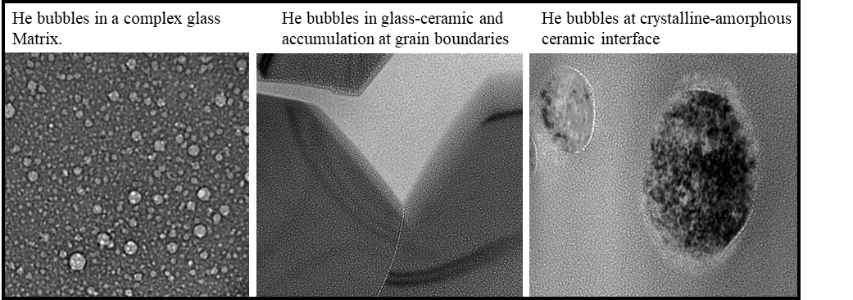Glasses due to their ease of manufacture and flexibility to easily accommodate a variety of elements are currently used for the storage of nuclear waste. In addition, the discovery of many naturally occurring radioactive ceramics has also raised the possibility of using these materials and their derivatives for nuclear waste confinement.
Irrespective of the nature of the waste storage matrix, decay of the confined radioisotopes will lead to self-irradiation damage. In the short-term (a few hundred years), intense beta and gamma irradiation in conjunction with helium accumulation and displacement damage—primarily due to alpha decay of the short-lived isotopes (such as 244Cm)— will be the dominant irradiation source. In the long-term (hundreds to thousands of years), only alpha decays will be dominant, leading to persistent displacement damage and helium accumulation. To evaluate the impact of the irradiation damage and helium accumulation on the long-term stability of the waste matrices, it is crucial to correctly simulate the effects of millions of years of radiation damage and gas accumulation on a laboratory timescale to be able to plan to mitigate any detrimental effects.
Our work at the MIAMI facility is focussed on investigating the behaviour of noble gases (decay products) in a variety of glass and glass-ceramic composite materials to understandthe role played by glass composition and glass free volume, interfaces, grain boundries and temperature on the migration and precipitation of noble gases. The final goal is to address, at a fundamental level, the fate of the helium gas in nuclear waste matrices and whether helium accumulation and displacement damage affect the chemical leaching and mechanical properties of the waste matrices.

Figure: (left) Helium bubbles in a 30-component borosilicate nuclear waste surrogate matrix, (middle), Helium bubbles in a glass ceramic with zirconolite as a major ceramic phase. In addition to the formation of helium bubbles inside the ceramic matrix, bubbles accumulate at the grain boundaries, (right) Accumulation of helium bubbles at the interface of a crystalline inclusion (Zirconia) and amorphous ceramic phase (zirconolite).
